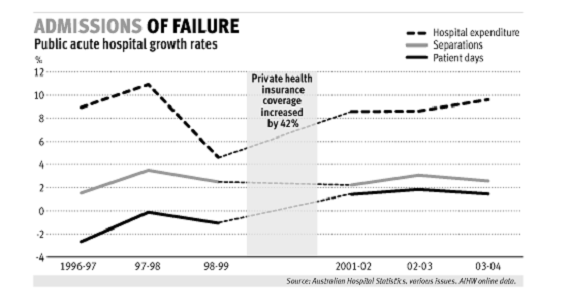Time to review health insurance policy
The Weekend Australian,
19-20 July 2008, p. 16 (Weekend Professional Health)
THAT there is much objection to raising the income thresholds under the Medicare levy surcharge is puzzling.
We should remind ourselves that the surcharge was introduced to "encourage" high-income earners to buy private health insurance. The old income thresholds of $50,000 for singles, and $100,000 for families, were put in place in 1997-98. Individuals and families earning these income figures could perhaps be considered well-off in 1997, but could hardly qualify as high-income earners nowadays, considering how much petrol prices, interest rates and house prices have increased.
Raising the income thresholds is not only being true to the spirit of the original intention of the surcharge, but also serves a more important purpose of removing an anomaly in the Australian health system: that consumers buy health insurance not because they need it, but on the advice of their accountants.
Many people, especially the young, buy private hospital insurance to avoid the surcharge but do not intend to use it due to high excesses; rather, they would elect to be admitted as public patients should they need hospital care.
While raising the income thresholds would prompt some people to drop their private hospital cover, it is not at all obvious that this lower coverage would lead to catastrophic outcomes for our public hospitals. The belief that fewer people covered by private health insurance is synonymous with greater pressure on public hospitals is misguided.
Let's take a closer look at hospital utilisation before and after the private health insurance policy reforms in the late 1990s. Immediately after the 1997-2000 policy reforms, national coverage of private health insurance went up from about 31 per cent to 44 per cent. The increase of 42 per cent took place between December 1999 and June 2000 and is massive by any measure.
Was there a drastic easing of pressure on public hospitals? Did the government spend less on public hospitals?
Let's compare hospital statistics three years before and after the massive jump in coverage using published AIHW data. We look at three different statistics on public acute hospitals: separations (number of discharges), patient days and government expenditure on public acute hospitals.
The first two are common measures of hospital output, which indicates utilisation. The last measure gives an indication of whether there is any break in government spending patterns on public hospitals.
The graph shows that separations (the middle curve) at public acute hospitals were growing at about the same rate before and after the jump in coverage, while patient days (the bottom curve) were declining (growth rates were negative) before the jump in coverage, but were increasing thereafter. Both measures show no discernible improvement in terms of public hospital utilisation.
In terms of government spending on public hospitals, spending continued to increase: the average annual growth rate was 8.1 per cent during 1996/97-1998/99, but was 8.9 per cent during 2001/02-2003/04. Thus, following a 42 per cent increase in private hospital coverage, we see no corresponding decline in public hospital utilisation, nor any change in government spending on public hospitals.
Now the puzzle: if a 42 per cent increase in private health insurance coverage did nothing to relieve the pressure on public hospitals, why would raising the income thresholds (which may lead to a decline in private health insurance membership, but surely not by 42 per cent) result in catastrophic outcomes for public hospitals?
In fact, I would submit that tinkering with the income thresholds is not enough. Given this budget's focus on containing inflation, it is time for the government to review the entire private health insurance policy, particularly the 30 per cent premium rebate.
The rebate has been costing the government well over $3 billion a year, but what does it buy for Australia? When it was introduced in 1998/99, it did help in raising the private health insurance coverage. But as the graph shows, this increase did nothing to ease the pressure on public hospitals.
Furthermore, research at the Melbourne Institute shows that between 35 to 55 per cent of the $3 billion-plus subsidy is a total waste of money in so far as inducing high-income earners to buy insurance. These people have already had, and will continue to have, insurance whether they get a 30 per cent rebate or not.
What is certain is that the subsidy improves the financial performance of health funds. Gross industry margins have been increasing steadily from around 10 per cent in 2001-02 to 15 per cent in 2006-07. Little wonder the health funds fought tooth and nail to keep membership at current levels.
Jongsay Yong is Senior Research Fellow at the Melbourne Institute of Applied Economic and Social Research

